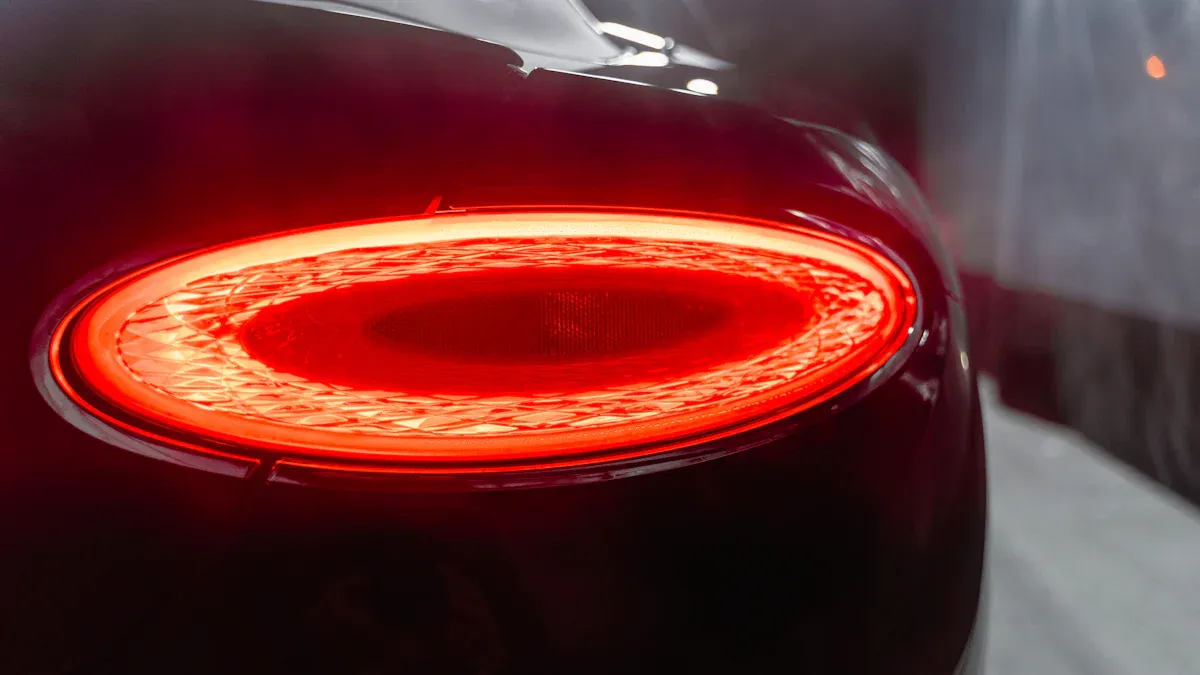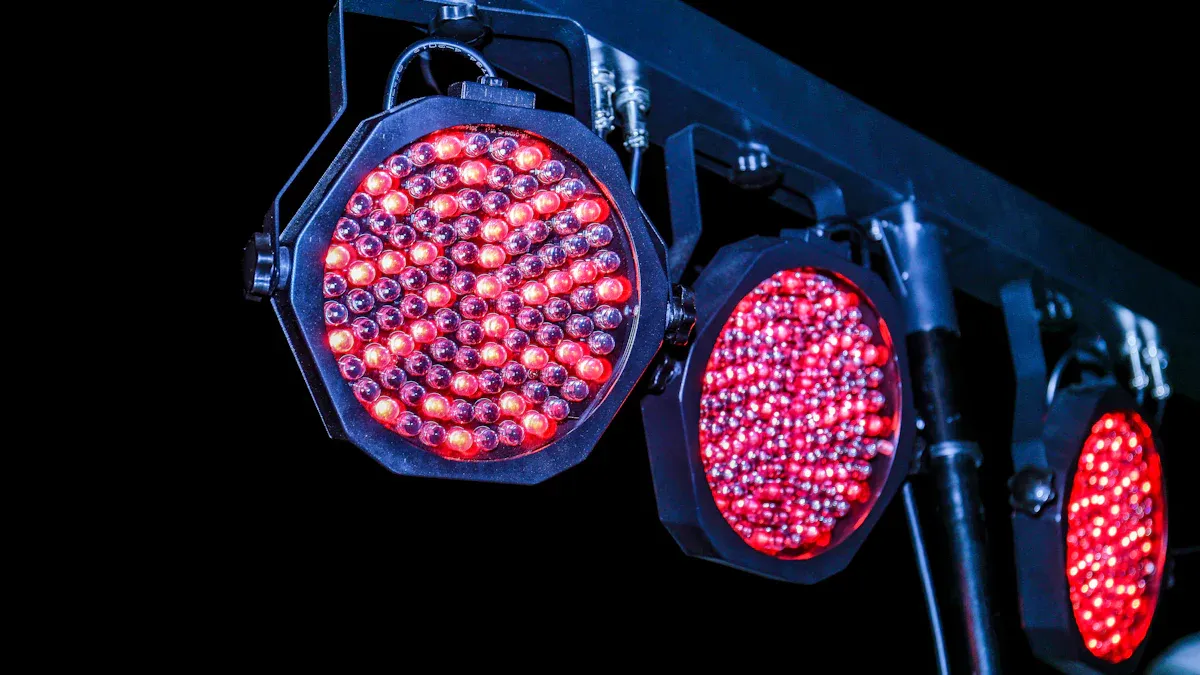LED Stop Lights: Applications, Benefits, and Installation

You see LED stop lights every day. These special lights use advanced technology to help you stay safe on the road. When you choose LED stop lights, you get brighter signals and save energy. Many people use them for cars, trucks, and even at Home. If you want to learn more, check the About Us or Product pages for more details.
Key Takeaways
LED stop lights use new technology. They are brighter and faster than old bulbs. They also use less energy.
These lights help keep people safe. They turn on right away. They are easy to see in any weather. This helps stop accidents on roads and at work.
LED stop lights last a long time. You do not need to replace or fix them often. They also help save money on energy.
These lights can be used in many places. People use them in cars, traffic lights, and factories. They are good for any place that needs clear signals.
You need to install LED stop lights the right way. Use the right tools and follow safety rules. This helps the lights work well and last longer. It also keeps you and your car safe.
What Are LED Stop Lights?

LED Basics
LED stop lights are found in lots of places today. They use a special technology called light-emitting diodes, or LEDs. LEDs have changed how people use lights. They use less energy and last much longer than old lights. You can see LEDs in stop lights, flashlights, home lights, and TV screens.
LED stop lights are different from traditional incandescent stop lights. The table below shows how they are not the same:
Characteristic | LED Stop Lights | Traditional Incandescent Stop Lights |
|---|---|---|
Brightness | Significantly brighter, improves visibility | Softer, less intense light |
Response Time | Almost instantaneous illumination | Slight delay due to filament heating |
Energy Efficiency | Much more energy-efficient | Less efficient, more energy lost as heat |
Lifespan | Up to 25,000 hours | Around 1,200 hours |
Durability | Resistant to shocks and temperature changes | Fragile filament, less tolerant |
Heat Emission | Emits much less heat | Produces significant heat |
Cost | Higher initial cost, but cost-effective over time | Lower upfront cost, higher long-term costs |
Visibility in Weather | Improved in fog, rain, snow | Less effective in adverse weather |
Integration | Can work with smart car systems | No integration capabilities |
LED stop lights are brighter and turn on faster. They save more energy too. These things make them a good choice for modern lighting.
How LEDs Work
LEDs make light in a new way. Old bulbs heat up a tiny wire until it glows. This wastes a lot of energy as heat. LEDs use electroluminescence. Electricity goes through a semiconductor inside the LED. It makes light with very little heat. LEDs are about 75% more energy efficient than old bulbs.
LED stop lights have several important parts:
LED chip: This part makes the light. It is made from special materials like Gallium Nitride.
LED driver: It changes the power from your car or building to the right kind for the LED.
Heat sink: It is made from aluminum or copper. It keeps the LED cool.
Circuit board: It is usually made from metal-core materials. It helps move heat away.
Housing: It protects the LED and helps with cooling. It is often made from aluminum.
Lens or optics: Made from strong plastic, it spreads the light and protects the inside.
Tip: Strong materials and smart design help LED stop lights last longer. They also work better in tough weather.
LED stop lights use advanced materials and smart engineering. This makes them reliable, bright, and safe for many uses.
LED Stop Lights Applications

LED stop lights are used in many places every day. You see them on cars, city streets, and in factories. They are also found in parking lots and drive-thrus. These lights use new LED technology to make things safer. They help save energy in lots of different places. LEDs are used anywhere good lighting is needed.
Vehicles
You use LED stop lights when you drive or ride. Most cars have these lights now. They make up almost 89% of the market. Trucks and buses use them too. They have about 38% of the market. Motorcycles and scooters are starting to use LED stop lights more. This is because of new electric models and better lighting.
Vehicle Type | Adoption Context and Market Share (2024) |
|---|---|
Passenger Cars | Most cars use LED stop lights. They have about 89% of the market. Electric cars help this number grow. |
Commercial Vehicles | Trucks and buses use LED stop lights. They have about 38% of the market. More electric trucks and safety rules help this number grow. |
Two-Wheelers | Motorcycles and scooters are using more LED stop lights. Electric models and new lighting make this happen faster. |
LED stop lights are brighter and turn on quickly. They help keep you safe on the road.
Traffic Signals
Cities use LED stop lights in traffic signals. These lights are brighter than old ones. They last longer too. Studies show LED signals help lower accident rates. They also help reduce traffic jams. Fewer workers need to fix broken lights. This means less trouble for drivers.
Metric | Before LED Implementation | After LED Implementation | Change |
|---|---|---|---|
Accident Rates | Accidents happened often. | Accidents happen less. | Big drop in accidents. |
Congestion-Related Incidents | Traffic jams were common. | Traffic jams are rare. | Fewer traffic jams. |
LED signals help drivers see better in bad weather. This makes streets safer and keeps traffic moving.
Industrial Use
Factories and warehouses use LED stop lights for safety. You see them at loading docks and on forklifts. They are also in busy work areas. LED lights work well in tough places. They can handle heat, cold, and shaking. These lights give clear signals. They help stop accidents and keep work going smoothly.
Other Applications
LED stop lights are used in other places too. Some examples are:
Financial drive-thrus
Cashier stations
Toll booths
Car washes
Parking entrances and exits
Quick service lanes
Note: Parking lots use LED lights for clear signals. They also help save energy.
LED stop lights make these places safer and help things run better for everyone.
Benefits of LED Stop Lights
Energy Efficiency
Switching to LED stop lights saves a lot of energy. These lights use new technology to work better. LED stop lights use much less power than old bulbs. You get more light but use less electricity. This helps the planet by cutting down pollution. LED stop lights also help with saving energy and last longer.
LED stop lights use much less energy than older lights.
You save money on your energy bill every month.
LEDs are safer for the environment because they do not have mercury.
Their strong design makes them last longer and work better.
Cities that use LED stop lights save lots of money. For example, Columbus, Mississippi, saved $100,000 each year with LED streetlights. You pay less for electricity and fixing lights. West Columbia saved $2 to $4 every month for each streetlight. This shows how LEDs help cities save money.
Lifespan
LED stop lights last a long time. They work much longer than halogen or incandescent bulbs. LEDs can shine for up to 60,000 hours. Halogen bulbs only last about 1,200 hours. Incandescent bulbs last about one year. LEDs can last eight years or even more. You do not need to change bulbs often. This saves you time and money.
Light Type | Typical Lifespan (hours) | Power Consumption (watts) |
|---|---|---|
LED | ~8 | |
Halogen | 800 - 1,200 | ~90 |
LEDs need very little fixing. Their long life means cities and businesses spend less on repairs. Modular designs make fixing easy. Technicians can fix parts fast without special tools. You spend less on work and parts. You also avoid problems with lights going out.
Tip: Pick LED stop lights because they last long and need little fixing. You save money and your lights work for years.
Visibility
LED stop lights help you see better. These lights spread light evenly across the road. You do not get glare or dark spots. It is easier to see signs, lines, and other cars. LED stop lights make it easier to see and react quickly.
Less glare means your eyes do not hurt.
You can see people, bikes, and dangers better.
Colors look clearer so you notice important things.
LED stop lights turn on right away. This gives you extra time to stop in emergencies. Fast lighting helps keep you safe and lowers crash risk. You get better lighting, especially at night or in bad weather.
Safety
LED stop lights help keep you safe. They are brighter and turn on faster. Studies show fewer rear-end crashes after cities use LED stop lights. Quick lighting gives drivers more time to stop. This helps prevent accidents.
Intersection Type | Crash Modification Factor (CMF) | Safety Impact |
|---|---|---|
Four-leg | ~0.827 | Fewer rear-end crashes |
Three-leg | >1.0 | No clear improvement |
LED stop lights are tough. They can handle bad weather and bumps. Your lights stay on and work well. You get fewer outages and safer roads. LED stop lights are smart for anyone who wants safety.
Note: LED stop lights make driving safer by making roads brighter and clearer. You help keep yourself and others safe when you use them.
LED Stop Lights Installation
Tools Needed
Before you start, gather all the tools and materials you need. Having the right tools makes the job easier and helps you avoid mistakes. Here is a list of what you should have:
Weatherproof connectors to keep water out of the wiring
Inline fuses or circuit breakers for electrical protection
Relay systems to handle high power safely
A master kill switch to turn off the system quickly if needed
Programmable switch boxes or control modules for advanced setups
Screwdrivers and pliers for removing and installing parts
Wire strippers and cutters for clean wiring
Electrical tape or heat shrink tubing for insulation
Mounting hardware, such as screws, bolts, or clips
Magnetic mounts for quick installation and removal
Permanent bolt-on mounts for a secure fit
Suction cup mounts for temporary or interior use
Tip: Always use clean, secure wiring and make sure you use the right fuse to protect your vehicle’s electrical system. Check that the stop light is visible from all angles before you finish.
Safety Steps
You must follow safety steps to protect yourself and your vehicle. The table below shows common hazards and how to avoid them:
Safety Hazard | Description | Mitigation Strategies |
|---|---|---|
Overheating | LED lights can get too hot if they do not have enough air or use the wrong power. | Give space for air to move, use heat sinks, and pick the right power supply. |
Electrical Shorts | Bad wiring or damaged parts can cause shorts. | Use insulated connectors, follow instructions, and keep wires dry. |
Fire Risk | Overheating or placing lights near flammable things can cause fires. | Use fire-resistant materials, keep air moving, and do not mount on flammable surfaces. |
Improper Installation | Wrong mounting or using too many lights can cause problems. | Follow the guide, use the right mounts, and test before final setup. |
Eye Strain from Blue Light | Bright blue light can hurt your eyes. | Use warmer LEDs, adjust brightness, and do not look directly at the lights. |
You should also use LED stop lights that have safety certifications like UL, CE, or ETL. These labels mean the lights have passed tests for electrical safety and fire resistance. Pick power supplies with built-in protections, such as over-current and short-circuit safeguards.
Note: Always turn off the power before you start working. Wear gloves and eye protection to keep yourself safe.
Installation Steps
Follow these steps to install your LED stop lights:
Turn off the power to the area where you will work. If you are working on a vehicle, disconnect the battery.
Remove the old stop light or bulb. Use a screwdriver or the right tool for your setup.
Clean and dry the surface where you will mount the new LED stop light.
Attach the LED stop light using the chosen mount. For a quick job, use magnetic or suction cup mounts. For a long-term fix, use bolt-on mounts.
Connect the wiring. Use weatherproof connectors and make sure all wires are tight and insulated. Add an inline fuse or circuit breaker for protection.
If you use a relay or control module, connect it now. Follow the instructions from the manufacturer.
Secure all wires with clips or ties. Keep them away from moving parts and sharp edges.
Add a heat sink or use an aluminum mount if possible. This helps the LED stop light stay cool and last longer.
Place a diffuser over the LED if you want softer, more even light. Frosted or milky white diffusers work best for uniform light.
Double-check all connections and mounts.
Restore power or reconnect the battery.
Test the LED stop light. Make sure it turns on, is bright, and can be seen from all needed angles.
Tip: Do not overload the circuit. Use relay boards or power distribution units if you install more than one LED stop light.
Troubleshooting
Sometimes, problems happen during installation. Here are common issues and how you can fix them:
If the LED stop light flickers or does not turn on, check all wiring connections. Loose wires cause most problems.
If you see buzzing or hear noise, you may have the wrong LED driver. Use a driver with the correct voltage and wattage.
If the light is dim or uneven, check for voltage drop. Use thicker wires or shorten the wire run.
If the LED gets too hot, add a heat sink or use an aluminum mount. Make sure air can move around the light.
If you notice electromagnetic interference, move the wires away from other electronics or use shielded cables.
If you see glare or bright spots, try a frosted or milky white diffuser for better light spread.
If the light fails often, use higher quality LED products and check for damage or moisture.
Regular checks and good maintenance help keep your LED stop lights working well and improve their performance.
LED stop lights shine brighter and use less energy. They turn on fast and help you see better. You can find them in cars and traffic lights. Factories and warehouses use them too. Research shows LEDs make roads safer. They last longer than old lights and save money.
Key Benefit | Explanation |
|---|---|
LEDs stay cool, so they are safer to use. | |
Energy Efficiency | They shine light where it is needed, saving power. |
Longer Lifespan | LEDs work for many years without breaking. |
Environmental Safety | LEDs do not have harmful stuff inside. |
Experts say switching to LEDs is smart and saves money. You can read more in guides from Availed Technologies and Optraffic. New LED designs will help the planet and make lighting even better.
FAQ
What makes LED stop lights better than regular bulbs?
You get brighter light and faster response with LEDs. These lights use less energy and last much longer than regular bulbs. You also save money on replacements and repairs.
Can you install LED stop lights by yourself?
Yes, you can install them with basic tools. Always turn off the power first. Follow the instructions in your manual. If you feel unsure, ask a professional for help.
Do LED stop lights work in cold or rainy weather?
LED stop lights work well in all weather. They resist cold, heat, and moisture. You see clear signals even in fog, rain, or snow.
Are LED stop lights safe for the environment?
Yes, LED stop lights do not contain mercury or other harmful materials. They use less electricity, which helps reduce pollution. You help the planet when you choose LEDs.

